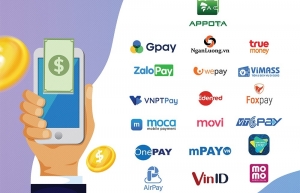The most innovative strategies for e-wallet survival
The e-wallet market is fiercely competitive. The rivalry comes not only from other e-wallet providers but also from formidable opponents like banks. This competition is evident in five key areas.
 |
| The most innovative strategies for e-wallet survival, photo Le Toan |
Firstly, the gap in payment processing between e-wallets and banks is closing rapidly. Banks have developed their apps quickly and efficiently, resulting in high user growth rates. Secondly, the swift adoption of VietQR has diminished the effectiveness of e-wallet QR codes, forcing e-wallets to transition to VietQR, as seen with Momo and ZaloPay.
Thirdly, a robust ecosystem of payment processing solutions that do not require an e-wallet licence is emerging. Solutions like ATOM, Casso, SePay, HeNo, and GenZi are directly integrated with banks.
Next, as security regulations tighten, the user experience of e-wallets increasingly relies on bank infrastructure. Lastly, banks’ profitability far outstrips that of e-wallets, enabling banks to invest significantly more in their technology.
Amidst this intense competition, e-wallets must carve out their niches. Payoo, for example, is known for its all-in-one payment solution, integrating a merchant ecosystem and Paybill and PayCode systems.
However, this sector is becoming saturated, and Payoo needs additional services for integration. Momo, with the largest user base, is developing into a super app offering a wide range of services.
Its standout market offerings, like movie tickets, highlight its innovative edge. However, banks slowly encroach on its market share.
ZaloPay, second to MoMo in market share, leverages the Zalo ecosystem and offers similar services but needs unique, exclusive features to differentiate itself. SmartPay focuses on SmartPOS and operates as a white-label solution for banks, with significant potential.
VNPAY operates symbiotically with bank apps it has developed, and ShopeePay functions as a feature for Shopee, similar to Moca for Grab. Other e-wallets are mostly inactive or generate negligible revenue.
In this competitive landscape, banks continuously invest in research and feature enhancements for their apps, making it challenging for e-wallets to outpace these giants.
However, e-wallets can pursue viable strategies based on market demand and future trends. Higher automation for financial needs, such as rapid loans, overdrafts, merchant cash advances, and daily wage advances, addresses immediate needs that few banks or financial institutions currently meet.
Integration with bank app ecosystems, like VNPAY’s Taxi/VNShop and UrBox’s loyalty programmes, leverages the massive online user base of over 180 million bank app users to expand their offerings.
Development of hardware and open API integration allows third parties to support banks by optimising costs and reducing operational hardware through solutions like SmartPOS and mPOS.
Processing new payment infrastructures, such as handling systems like VETC and EPASS for new demands like metro systems, provides a competitive edge. For instance, the mandatory VETC/EPASS tags for vehicles create an irreplaceable advantage.
These strategies are also accessible to other tech companies that do not require e-wallet licences, broadening the competitive landscape further. As the market continues to evolve, e-wallets must remain agile and innovative to survive and thrive in this dynamic environment.
 | Fintech enterprises deploying innovative e-wallet initiatives to capture fair share A wide variety of innovative payment systems are expected to assist Vietnam in moving closer to its objective of achieving financial inclusion and a cashless society in the not-too-distant future. However, there will be fierce competition. |
 | MoMo dominates Vietnam's e-wallet market with 68 per cent share The cashless payment landscape in Vietnam is experiencing a surge of activity, with MoMo emerging as the dominant player in the e-wallet sector. Positioned at the forefront of this dynamic market, MoMo has solidified its position as the go-to choice for Vietnamese consumers seeking convenient and secure digital transactions. |
 | Visa partners with Vietnamese e-wallet apps Visa has announced a new partnership with three of the most popular e-wallets in Vietnam – MoMo, VNPAY and ZaloPay – to provide a more convenient payment experience for cardholders at participating small- and medium-sized enterprises (SMEs). |
 | E-wallet firms restructure for best interests of customers Intense competition in Vietnam’s e-wallet market is driving strategic shifts and forcing some players to rapidly develop apps or seek mergers. |
(*)Lu Duy Nguyen, head of Digital Banking OCB
What the stars mean:
★ Poor ★ ★ Promising ★★★ Good ★★★★ Very good ★★★★★ Exceptional
Related Contents
Latest News
More News
- Securing capital and efficiency for Vietnam’s 2026-2030 growth ambitions (December 17, 2025 | 10:00)
- Energy sector in need of blended finance mechanisms (December 17, 2025 | 09:00)
- Vietnam still has room to mobilise capital for sustainable growth (December 17, 2025 | 08:57)
- Long-term capital seen as key hurdle to green growth (December 16, 2025 | 08:00)
- Gold prices swing amid tax debate and import uncertainty (December 15, 2025 | 18:04)
- Agribank frames bank credit as catalyst for green growth (December 15, 2025 | 17:59)
- Vietnam’s green transition demands collective financial action (December 15, 2025 | 12:00)
- VIR workshop highlights capital and policy for sustainable development (December 15, 2025 | 11:00)
- Promoting digital assets initiative in Vietnam (December 13, 2025 | 09:30)
- Experts flag gaps as national financial strategy under review (December 12, 2025 | 15:13)

 Tag:
Tag:





















 Mobile Version
Mobile Version